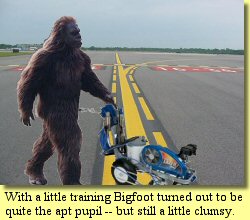 |
 |
MythbustersBy Mike Speidel
Right-brainers: see illustration below. Left-brainers: here are your numbers. Optimal bead embedment occurs
when 50-60% of the bead is anchored in the binding coating. The majority of type 4 beads are roughly 1.1 millimeters in diameter, twice
as large as type 1 or type 3 beads. 1 millimeter is equivalent to about 40 mils. Practically speaking, to achieve 50-60% embedment with
type 4 beads, you would need approximately 35 mils wet film (which dries down to approximately 22 mils) to anchor type 4 beads
effectively in 1952-D paint.
While that logic seems like it would be a feasible solution, alas, it's not that simple. Manufacturers of the 1952-D specification recommend that the coating be applied at 15 mils wet. When you start putting down a thicker coat, the paint often cracks and the marking is corrupted. It's a bit of a paradox: one that awakens me from a sound sleep fortnightly. If you haven't heard, a new paint specification has recently been released: 1952-E... predictably. Within this specification there are three subtypes: Type 1, Type 2, and Type 3 (the creativity amazes me). 1952-E (Type 3) is a high-build acrylic that has been formulated to be applied at a much thicker rate while resisting cracking. This coating may work well in a marking system with type 4 beads, however we have yet to observe any uses of the new specification on airfields. Another day, another myth busted - that's why I make the big bucks... if you believe that you forgot what article you're reading. This article was brought to you, in part, by the letters "D", "E", and by the number 1,952. Thanks for reading! |

 Welcome to my precious space - wait - that could easily be taken out of context. Welcome to a less
ambiguous description of my contribution in the Summer '07 Webletter. Today's myth is all about paint and beads, specifically
type 4 beads (the big ones). I have been noticing a distressing pattern around the country: type 4 beads in airfield markings being
"knocked out". Bead loss is not a big issue for daytime operations, but represents a very big issue in low visibility conditions
(when we rely on markings). Why does it happen? Simply put, type 4 beads generally can't anchor well when the recommended
amount of 1952-D coating is applied.
Welcome to my precious space - wait - that could easily be taken out of context. Welcome to a less
ambiguous description of my contribution in the Summer '07 Webletter. Today's myth is all about paint and beads, specifically
type 4 beads (the big ones). I have been noticing a distressing pattern around the country: type 4 beads in airfield markings being
"knocked out". Bead loss is not a big issue for daytime operations, but represents a very big issue in low visibility conditions
(when we rely on markings). Why does it happen? Simply put, type 4 beads generally can't anchor well when the recommended
amount of 1952-D coating is applied.
